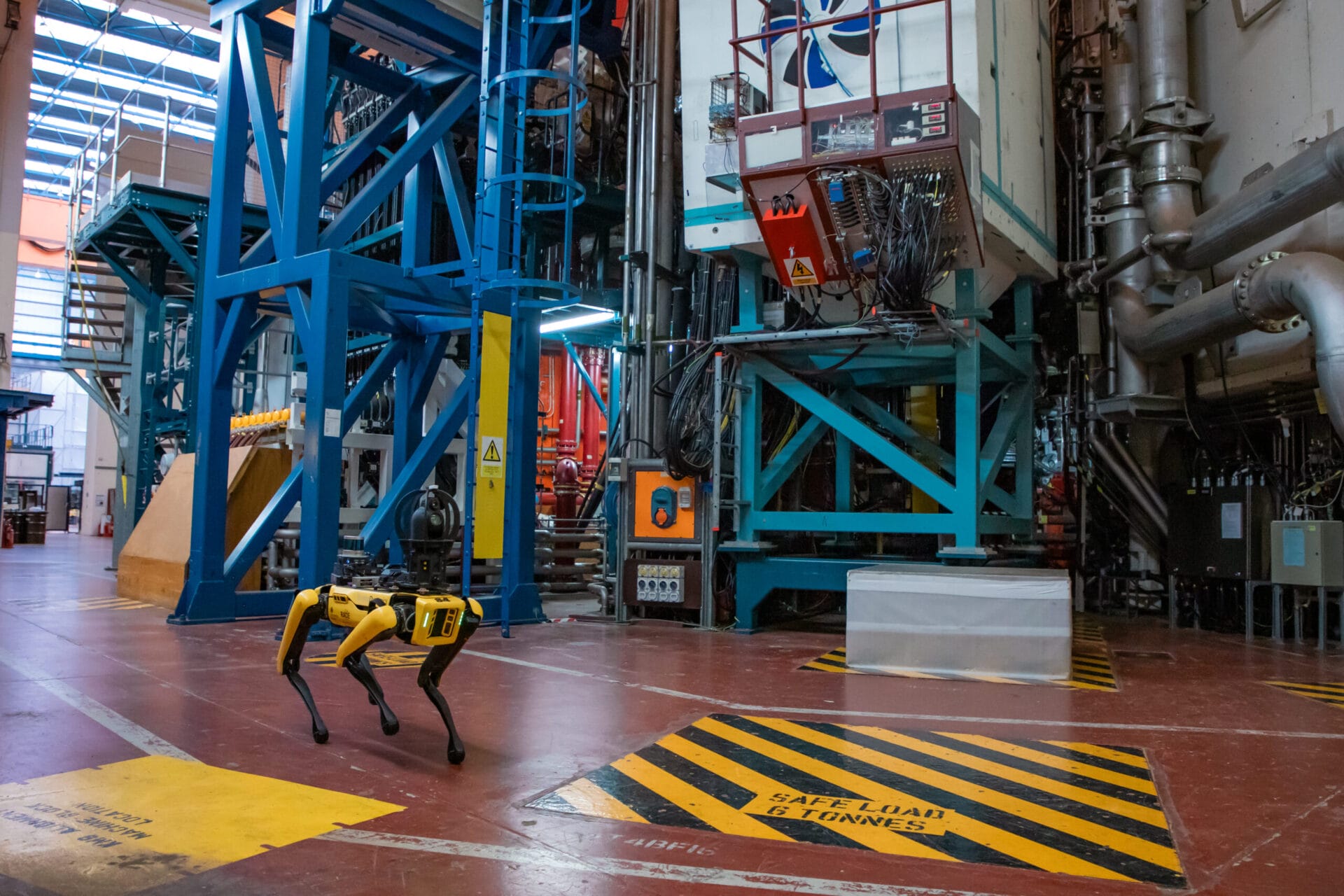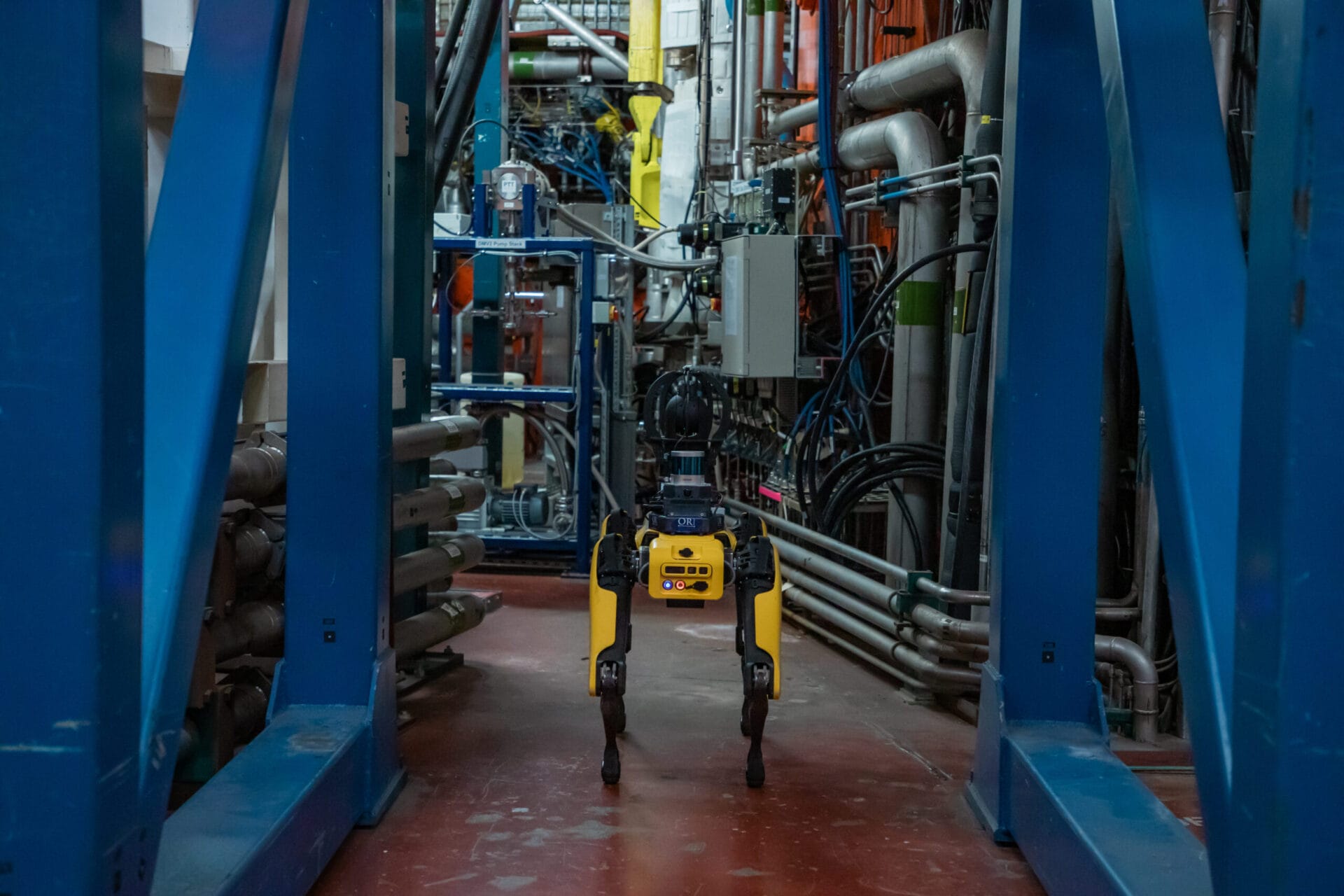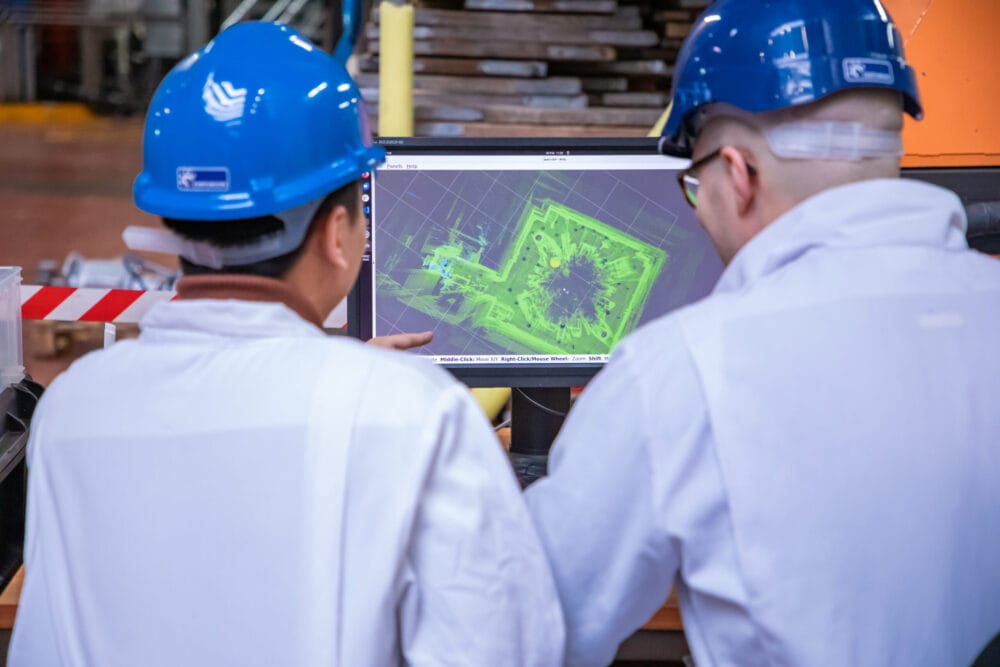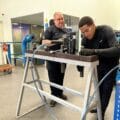- World-first autonomous robot inspection inside a fusion energy facility
- Autonomous maintenance is mission critical for future fusion powerplants and also demonstrates potential for efficient nuclear decommissioning, environmental clean-up, and disaster relief

Autonomous SPOT Deployment in JET Torus Hall
In a world-first, a fully autonomous robot has been used to inspect the inside of a fusion energy facility.
The United Kingdom Atomic Energy Authority (UKAEA) and the Oxford Robotics Institute (ORI), University of Oxford, have achieved a first-ever autonomous robot deployment in a fusion facility.
The 35-day trial took place in UKAEA’s Joint European Torus (JET) facility, which until its recent scientific operational shutdown, was one of the largest and most powerful fusion research machines in the world.
In a step towards the commercial viability of fusion energy, a world-leading robotics alliance has successfully demonstrated that part of a fusion facility’s maintenance can be carried out by an autonomous robot, thus making such work safer for humans and more cost efficient for its operator.
Fusion powerplants will need regular maintenance. Traditionally, robotic inspections required humans to make decisions and to operate.
“The project aimed to validate the reliability of autonomous robotic technology and instil trust and confidence in their use for safe and efficient inspections in fusion facilities over extended periods,” said Dr Robert Skilton, Head of Research, at UKAEA’s Remote Applications in Challenging Environments division.
Such advancements pave the way for autonomous maintenance and decommissioning in future fusion facilities where human access may be limited owing to challenging conditions posed by radiation, vacuum-level pressure and extreme temperatures.
JET provided the ideal opportunity to test ORI’s autonomy platform “AutoInspect” controlling a Boston Dynamics Spot quadruped robot in an environment still hazardous after two high-powered deuterium-tritium experiments in the space of three years.

Autonomous SPOT Deployment in JET Torus Hall
“This deployment demonstrates that autonomous robots can enhance safety and cut costs. These ‘next generation’ solutions are becoming ready to be used in other industrial facilities such as nuclear decommissioning, environmental clean-up, and disaster relief,” Dr Skilton continued.
The inspection tasks within JET involved mapping the entire facility, taking sensor readings of its environment, and avoiding obstacles and personnel involved in the decommissioning process.
To address these challenges, UKAEA’s inspection payload was integrated with ORI’s localisation and mission autonomy solutions, developed through a collaboration between Professors Hawes’ and Fallon’s teams. This setup was combined with Boston Dynamics’ hardware and collision avoidance technology to enhance the robot’s capabilities.
This integrated robotic system collected essential data on JET’s environment and overall status twice a day. This allowed the team to assess the feasibility of replacing human inspections with fully autonomous processes.
Prof. Nick Hawes, Professor of AI & Robotics, University of Oxford, said of ORI’s aims in the project, “Projects like this demonstrate the value of autonomous robots – robots that can do things themselves without direct control of humans. They also ground our science in real use cases, and provide requirements and constraints that drive us to invent new AI and robotics algorithms.”
ORI’s work in this project was supported by the Engineering and Physical Sciences Research Council through the Embodied Intelligence: From Sensing to Collaboration programme grant which aims to create autonomous systems that enhance human capability and potential.

Autonomous SPOT Deployment in JET Torus Hall
The results will assist planning for the next stages of the JET decommissioning and repurposing (JDR) programme.

About UK Atomic Energy Authority
UKAEA is the national organisation responsible for the research and delivery of sustainable fusion energy. It is an executive non-departmental public body, sponsored by the Department for Energy Security and Net Zero.
UKAEA runs the fusion machine MAST-Upgrade (Mega Amp Spherical Tokamak) and is delivering the transition of JET from plasma operations to repurposing and decommissioning. The insights gained from this process will contribute to the advancement of sustainable future fusion powerplants.
STEP (Spherical Tokamak for Energy Production) is a UKAEA programme that will demonstrate the ability to generate net energy from fusion. It will also determine how the plant will be maintained through its operational life and prove the potential for the plant to produce its own fuel. The first phase of the programme is to produce a concept design by 2024.
In 2023, UKAEA was allocated £650 million for the UK’s alternative programme to associating to Euratom R&T. The funding aims to foster world-leading innovation whilst stimulating general industry capacity through international collaboration and the development of future fusion powerplants.
UKAEA also undertakes cutting edge work with research organisations and the industrial supply chain in a wide spectrum of areas, including robotics and materials.
More information: https://www.gov.uk/ukaea
Social Media: @UKAEAofficial
About fusion energy
When a mix of two forms of hydrogen (deuterium and tritium) is heated to form a controlled plasma at extreme temperatures – 10 times hotter than the core of the Sun – they fuse together to create helium and release energy which can be harnessed to produce electricity. There is more than one way of achieving this. UKAEA’s approach is to hold this hot plasma using strong magnets in a ring-shaped machine called a ‘tokamak’, and then to harness this heat to produce electricity in a similar way to existing power stations.
About RACE
Since opening at Culham in 2016, UKAEA’s RACE (Remote Applications in Challenging Environments) facility has conducted R&D into the use of robotics in extreme industrial environments where it is difficult to send people to carry out work. It also supports companies developing their own autonomous systems. RACE is a key centre for implementing the Government’s Robotics & Autonomous Systems strategy, which aims to equip the UK to compete in this emerging global industry.
More information: https://race.ukaea.uk/
About the Oxford Robotics Institute
The Oxford Robotics Institute (ORI) is the University of Oxford’s centre for autonomous robotics research. ORI brings together close to 100 researchers, engineers, and professional support staff, working from basic science to translational projects and ambitious field deployments. The ORI was recently awarded a Queen’s Anniversary Prize, recognising its innovative research and societal impact, including its role in accelerating the uptake of robotics and AI in the nuclear industry.








